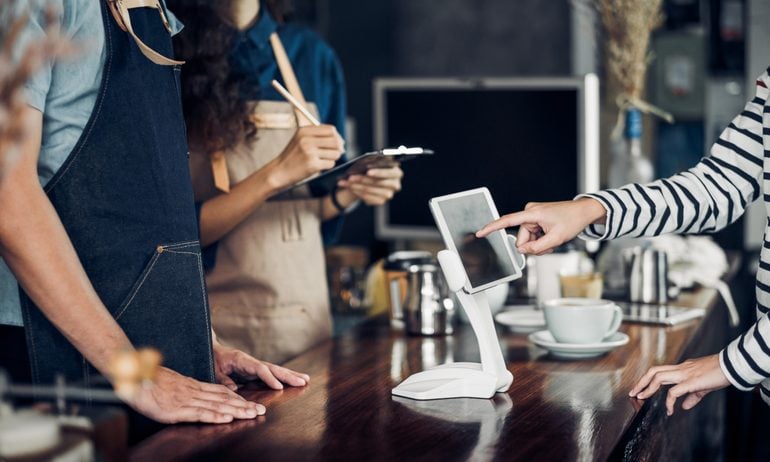5 Strategies for Navigating Today’s Digital Tipping Culture
Digital tipping prompts can feel uncomfortable, but following a few strategies makes responding easier.

Many, or all, of the products featured on this page are from our advertising partners who compensate us when you take certain actions on our website or click to take an action on their website. However, this does not influence our evaluations. Our opinions are our own. Here is a list of our partners and here's how we make money.
The nearly universal experience of finding yourself face-to-face with a checkout counter screen asking you to select an amount to tip for service can prompt a cascade of awkward questions: How much should you tip on a $5 coffee if anything? How can you decide before the cup has even been poured? Is it rude to select “no tip,” then slink away with your drink?
The answers to those questions vary depending on whom you ask, but tipping experts agree on one thing: We get prompted to tip much more frequently these days, largely because of the explosion of cashless payment methods with automated tipping options. Another thing they agree on: You don’t always have to say “yes.”
“During the pandemic and post-pandemic, we’ve seen a dramatic shift in the way tips are given. Suddenly, you see tablets where you are prompted to give specific tip amounts at points of purchase where never before would anyone have dreamed of giving a tip,” says Thomas Farley, also known as “Mister Manners,” a New York-based etiquette expert and keynote speaker.
“Consumers want to be dutiful, good consumers, so many play along, but still feel confused,” Farley adds.
To sort out that confusion, consider following these five strategies for navigating current tipping culture:
Brush off any awkwardness
While you might feel put on the spot with the sudden appearance of the tipping screen at a checkout counter, Farley says you should feel justified in taking your time and making the best decision for you and your budget.
“Most servers I witness try to give you your space while you decide. Own your decision knowing you are fully supported by good etiquette guidelines either way,” he says.
“We are living through inflationary times when everything costs more. Unless you have tons of disposable income, you shouldn’t feel guilty about not tipping” at a checkout counter, even if an iPad tells you to, Farley adds.
Aim to tip 20% for most services
While tipping isn’t traditional at a coffee shop or convenience store counter, it is expected when you’re being served at a restaurant, where 20% is customary. Hairstylists, salon assistants, food delivery drivers and other service workers generally rely on similar percentage tips as a significant portion of their income.
Blake Hammerton, Dallas-based founder of The Sharp Gentleman, a coaching and lifestyle website for men, suggests adding 20% or rounding up to an even dollar amount for most services. As a former pizza delivery worker, he says he always appreciated tips based on the amount of effort he had to put into the job, including distance driven and the amount of food delivered. “Five dollars is great if it’s close by and a small amount, but if it’s eight pizzas for a party, you’ll want to tip more,” he says.
Carry some cash for traditional tipping
Lisa Mirza Grotts, an etiquette expert in the San Francisco Bay area, says that while many consumers no longer carry much cash, it’s still useful to have some on hand in certain situations, such as when tipping a hotel housekeeper or valet. She suggests keeping $5 and $10 bills handy, especially when you travel.
There’s also a time for larger bills. When you’re tipping on a big-ticket service, such as a $5,000 house move, Farley recommends having a few $100 bills on hand to pass out to the workers at the end. “There’s no need to tip 20%, but $100 would go a long way,” he says.
At the end of the year, Farley suggests tipping each service provider, such as a hairstylist, barber or nail technician, the equivalent of the cost of one visit, whether it’s $30 or $300. “Cash is king,” he says, adding that you can include a notecard with the tip.
For in-home service providers, such as a nanny or housekeeper, the end-of-year tip is generally one week’s pay, Farley says. And if you’re not sure how much to tip a service provider, he encourages an informal polling of neighbors since the answer can depend on location.
Consider your budget
Marianne Nolte, a certified financial planner and founder of the firm Imagine Financial Services based in Lake Havasu City, Arizona, was recently shocked by a prompt to tip while purchasing a smoothie at a drive-through window. “It felt excessive,” she says. “It was a drive-through, not a sit-down restaurant.”
“If tipping is expected and it’s too expensive, we do have other choices,” she says, noting that she could make her own smoothie at home to avoid the pressure to tip.
Ellie Austin-Williams, author of the forthcoming book “Money Talks: A Lifestyle Guide for Financial Wellbeing,” similarly encourages consumers to protect their budget from tipping-creep. “Just because the option is there to tip, don’t always feel you have to take it. Businesses are there to encourage us to spend more money, and it’s on you to manage your money. You’ve got to look after your own finances,” she says.
Embrace the joy of tipping
When you’ve received excellent service and you want to reward the people who provided it, tipping can be a positive experience — and no one leaves feeling awkward.
This article was written by NerdWallet and was originally published by The Associated Press.

